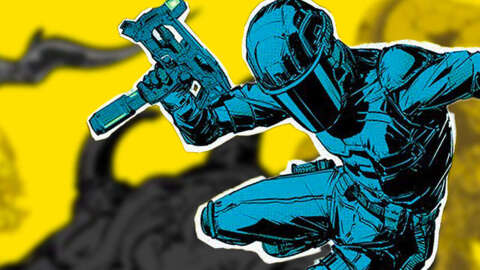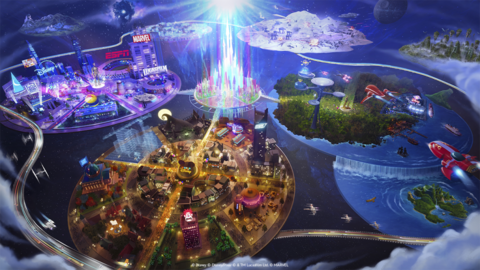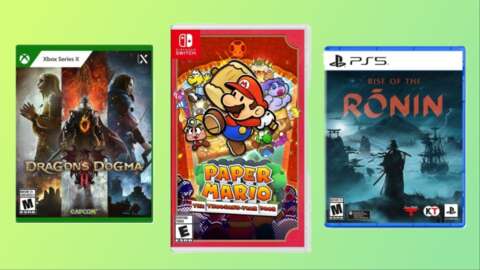Ahead of the release of [REDACTED] (yes, that’s actually the name of the game, brackets and all), I got to play a fairly substantial part of the upcoming isometric roguelike that takes place in the same world as The Callisto Protocol. And though I can’t talk about my impressions just yet, I can share a conversation I had with Striking Distance studio head Steve Papoutsis and creative director Ben Walker after playing the game. We discussed how the game started as a fun distraction that eventually became a spin-off of The Callisto Protocol, how the studio designed the Rival system to add a frantic undercurrent to each run of the game, and why [REDACTED] isn’t launching in early access like many roguelike games are these days.
In [REDACTED], you play as a guard trying to escape Black Iron Prison during the events of The Callisto Protocol. There’s only one escape pod left and there are other survivors–fellow coworkers or inmates called Rivals–all striving for that same goal. Each failed escape sees the guard die and join the infected, and you start a new run as another guard trying to escape. You can chase after the reanimated corpse of the previous guard you played as to recover some goodies but they’ll have every upgrade you unlocked in that run, making them quite formidable in comparison to normal enemies. As you progress, you can try to slow the Rivals down to surpass them or kill them, but they’ll be doing all they can to get rid of you too.
[REDACTED] is set to launch for PC on October 31.
GameSpot: So let’s address the obvious: What inspired a small part of the Striking Distance team to go from The Callisto Protocol’s over-the-shoulder action-horror format to an isometric roguelike dungeon crawler in [REDACTED]?
Walker: It really came organically. We were finishing up the DLC for [The Callisto Protocol]. A small group of people just started working on mechanics and fun and shooting and stuff, and it just kind of grew. It kept growing and growing and growing. So things definitely turned more towards the fun aspect of it and not so many constraints. So we’re just getting around with… We’re always fans of fighters and top-down shooters and stuff, and so when we started getting into that speed of mechanics, we moved the camera up so we could see what we were doing, and then started adding the shooting layer in there.
And so that’s really where it came from was some designers, a couple of engineers, just playing around and having fun. And then the rest of the team seeing it and adding to it. Art came in and they’re like, “Hey, what about this really cool comic style?” Okay, that’s great. VFX saw that and added their layer on top of it, and it just kind of gained a lot of momentum.
Normal enemies go down pretty quickly but they swarm if you’re not careful.
Did [REDACTED] start as a sequel to The Callisto Protocol or did the connection to that game come later in development?
Walker: Yes. It’s part of what we were doing when we were having fun and just playing around. We weren’t really expecting it to go anywhere. We were just working on stuff internally. And so we started kind of not joking around, but having fun with the idea of, “Well, if there really was this zombie outbreak in a prison, what about all the other people? What about the people that work there? What about just the regular guards? What would they be thinking? What would they be going through?” And from that fun aspect [we went], “Okay, well they’re probably like, ‘Screw this, I’m out of here.'” They’re not trying to save the world. They’re not trying to do all these things that we do and have fun with in other games. We just looked at the other side of it. And so since [then], we were based [on] that line of thinking. In that TCP kind of universe, but it’s a different kind of game altogether. One, we’re really just focusing on cool characters and fun gameplay.
Yeah. Usually, things are a lot more structured and planned out and stuff. This one just kind of gained a life of its own, and so it was really fun to be a part of it because I definitely hadn’t had that opportunity very often in my career.
Combat in [REDACTED] is way faster than The Callisto Protocol.
Internally, how do y’all refer to [REDACTED]? Is it a sequel, prequel, something else…?
Papoutsis: No. No. I mean, for us, once we started gaining momentum and really digging in on the concept, it was really important for us to decouple it from anybody thinking it was a sequel or overly connected to it.
One of the things that’s really important to us now that we’ve worked on it for a bit and we’re getting ready to launch it is that it’s accessible to anyone. So we didn’t want to have a barrier that, “Oh, you need to play TCP in order to play this game.” Or even vice versa.
They’re two separate games. There’s some very loose connection based on the location. But as Ben said, we’re not trying to save the world. We’re trying to get out. That was the whole idea that really clicked with us was, “Hey, if you went to work one day and all of a sudden there was a zombie outbreak, what would you be doing?” You’d be trying to find your way out of there as fast as possible. And oh, by the way, you got a bunch of coworkers and prisoners trying to do the same thing. And we just thought that sounded fun. That sounded different. It led into some of our unique mechanics like our rivals. It just really organically started to just fall into place, and the last thing we wanted to do was inhibit our creativity based on our previous game, which we do like our previous game, but this is a whole separate thing and we want it to be enjoyed on its own.
The Rivals pack a mean punch if you try to confront them too early.
Is that part of the reason for the Rival system? To differentiate this game from its roguelike contemporaries?
Walker: It was a system we hadn’t seen anywhere before either. And so that’s why we really put a lot of focus and effort into it because starting with the premise. What are these other people doing? They’re racing. So trying to put the mechanics together behind that. We didn’t want them to be in your way all the time, but we wanted them to be around and have their presence, but we also wanted them to be a threat. And so that kind of just naturally paired together well with that. We call it the rival attacks or the room modifiers. And for roguelikes, it’s all about keeping the game fresh and not knowing what you’re going to expect all the time. And so all of their attacks can happen in any different room, in any different combination. So it’s just a matter of keeping things, the player always guessing a little bit.
And then, I don’t know if you noticed. But if you get ahead of them in the race, they can’t attack you anymore, so it’s an incentive to keep ahead. They only attack you if they’re in front of you.
Yeah, we try to put a lot of strategy into it too and put a lot into our builds as well because you can build towards attacking them better and just you being faster means you’re naturally moving across the space quicker, and so we tried to add a whole layer there where you have to come in with different plans and different load-outs at different times.
You have to keep moving to stay alive.
If you kill a Rival, are they gone, gone? Do you just not see them in a run ever again?
Papoutsis: There’s a bit of a surprise, I guess. I don’t know how much we want to give away. But it’s a video game, so you’re going to have the Rivals. They’re not going to ever be gone, gone, but what happens to them, you have to play it and see.
We’ve seen a few games in this genre over the past three years or so launch in early access first–why the decision to launch in full out the gate?
Papoutsis: Yeah. So I mean, it’s interesting. You’re right. There’s a lot of different approaches right now in games. People doing early access, people doing betas, things of that nature. I think with us, the game started very organically and we just kept progressing along, and before you know it, we were like, “Hey, this thing’s almost done.” And I think if you’re going to do something like an early access [release], it makes a lot of sense to build that into your plan. So you kind of know. We need to get to this state, then we do an early access, and then you kind of have a different, more almost community-driven development. But I think in the unique instance of this game, that didn’t really factor in because we were just kind of going and making it.
I think there’s a lot of value to that style of approach and there’s a lot of games I enjoy that do that. But I think for REDACTED because it was more of this passion project that just came out of the blue in a way, we didn’t have the opportunity to really put forward that kind of planning. The community-driven development of early access, that’s a whole different mindset as well in terms of how you… Because if you’re going to do something like that, these teams that do it, they do it really well. They’re dedicated to being able to receive feedback and then take it in, ingest it, and modify and communicate, do all those things. But we were on a much different track when we started. So I think for us, the approach we took works, but I think there’s a lot of merit in all those different approaches and they’re all fun and different, and it’s important that people do get a chance to experience those things. But with our game, hopefully, people are there on the 31st and just ready to hop in and play.
There are boss battles beyond the Rivals.
In terms of story, does [REDACTED] tie into The Callisto Protocol in any way beyond both taking place in the same setting?
Walker: No. No. They’re completely different. You don’t need to know one to enjoy the other. We do have a lot of things that we were hoping the TCP players would notice and kind of just enjoy. But if you don’t know what they are, it doesn’t change the game. It’s just like you said, “Oh, I recognize that. I remember that,” for the people who enjoyed that other one. Timeline-wise is the only thing where this could potentially cross over, and this is right when the outbreak happens, but it’s kind of a parallel universe type of thing, so there’s no connection.
I think it was just because of the way the game naturally formed. We were playing around with some of the TCP weapons and stuff when we started, and so that’s what was in our toolbox, and we started expanding on it. And at some point, it just felt wrong to change it because everything was going so well. And so it was just there from the start. And we’ve had this conversation a couple of times along the way like, “How did it cross over and this?” And so that’s why we came… We didn’t want to put Callisto Protocol or anything in the name; [we] knew it was completely different, and so it just felt wrong at some point to make it somewhere else.
Sometimes there are just no good choices and you have to keep shooting and hope.
How did the art style and sound design come together? The comic book-inspired art and rock music makes for a very different vibe from The Callisto Protocol.
Papoutsis: The inspiration for the art, I think it comes from a bunch of different places. I think a lot of the folks on the team really enjoy graphic novels and comics and things like that. And then, the other part of it was really trying to make it have its own visual identity. I think with The Callisto Protocol, it is a highly detailed, more photorealistic world. I’m very proud of the visual achievements the team was able to achieve there. But on this, we wanted it to feel different. We wanted it to have a different identity, more of an aggressive, frenetic, almost fast-type of feel to it.
And that art style really resonated with us as we looked at it. It was just like, “Wow, this looks really different.” It fits into the general feeling we want players to have, which is primarily fun. That’s the first thing. We just want people to have fun. We want them to feel the speed and the smooth controls, get to play with all the different experiments that they get. Everything really tied off of the controller.
And so having that visual identity just felt natural to that style and approach. So it just hearkens back to just older games. It just has more of an arcade-y style approach versus something that feels very serious and very deliberate, very photorealistic. And in a way, it was very liberating for the team because we’re not constrained by those things. Somebody saying, “That’s not what that looks like.” In this world, it can look however we want it. And so I think that’s very liberating in terms of your creative freedom with the art stuff.
Walker: With all the different colors and everything, it helped the gameplay out just like Steve was talking about, because we have these separations of what’s going to do what to you, so everything’s easy to read because things happen really, really fast. And so there’s no room for subtlety in this. And that enabled us just to help pull all those gameplay elements and those different experiments together.
This interview was edited for both brevity and readability.


